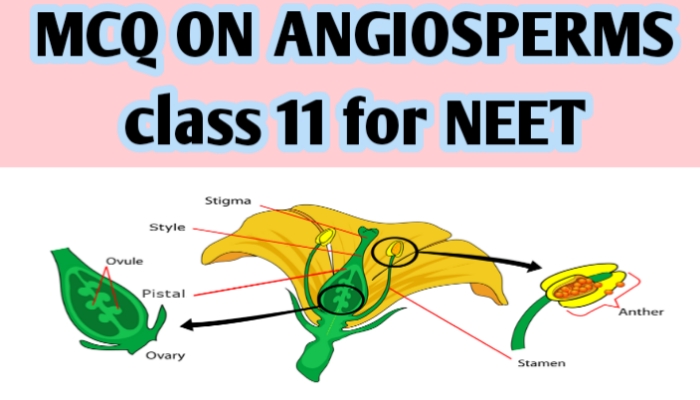MCQ ON ANGIOSPERMS class 11 for NEET | MCQ ON —NEET Biology class 11th 2022 MCQ Questions for class 11 Biology chapter 2 | ANGIOSPERMS with Answer | Check the below NCERT MCQ question for class 11 Biology chapter 2 based on ANGIOSPERMS with Answers.

MCQ ON ANGIOSPERMS class 11 for NEET
MCQ Questions for class 11 Biology with Answers were prepared based on the latest pattern.
We have provided class 11 Biology MCQs questions on ANGIOSPERMS with Answers to help students understand the concept very well.MCQ on Protista is useful for NEET/ CSIR/ UGC/ CBSE/ ICSE /AIIMS EXAM/ AFMC EXAM/ STATE LEVEL/ JAC exam MEDICAL EXAM 2022-23
Introduction:-
The Angiosperms or flowering plants , constitute the most dominant and ubiquitous vascular plants of present day flora which changed the green and yellow melancholy of the earth’s vegetation by the colourful brightness and fragrance of their flower.
The term angiosperm means enclosed seed because the ovules or potential seed are enclosed within a hollow ovary. Angiosperms far exceeds all other major group of living plants in number and diversity of form and structure.
MCQ ON ANGIOSPERMS class 11 for NEET
1.Angiosperm have dominated the land flora primarily because of their
(a) Property of producing large number of seeds
(b) Nature of self pollination
(c) Domestication by man
(d) Power of adaptibiliy in diverse habitat.
Ans (d) Power of adaptibiliy in diverse habitat
2.Which differentiates leaf of dicots from monocots?
(a) Parallel venation
(b) Differentiate of palisade and spongy parenchyma
(c) Stomata only on upper side
(d) Stomata both on upper and lower sides
Ans. (b) Differentiate of palisade and spongy parenchyma
3.Which one of the following contain xylem vessels?
(a) Bryophyta
(b) Pteridophyta
(c) Gymnosperm
(d) Angiosperms
Ans. (d) Angiosperms
4.Double fertilisation is found without any exception in
(a) Bryophytes
(b) Gymnosperms
(c) Angiosperms
(d) Pteridophytes
Ans.(c) Angiosperms
5.The embryo sac of an Angiosperms is made up of
(a) 8 cells
(b) 7 cells and 8 nuclei
(c) 8 nuclei
(d) 7 cells and 7 nuclei
Ans.(b) 7 cells and 8 nuclei
ALSO READ:-
● YOU CAN WATCH BIOLOGY SIR Youtube channel
6.If the diploid number of a flowering plant is 36, what would be the chromosome number in its endosperm ?
(a) 36
(b) 18
(c) 54
(d) 72
Ans.(c) 54
7.The male sex organ in a flower is the
(a) Stamen
(b) Pistil
(c) Petals
(d) Sepals
Ans.(a) Stamen
8.The female sex organ in a flower is the
(a) Stamen
(b) Pistil or Carpel
(c) Sepal
(d) Petal
Ans.(b) Pistlil or Carpel
9.Each cells of an embryo-sac is ?
(a) Haploid
(b) Diploid
(c) Triploid
(d) Tetraploid
Ans. (c) Haploid
10. Each embryo-sac has a three celled egg apparatus consist of ?
(a) one egg cell and two synergids
(b) two egg cell and one synergids
(c) Fruiting bodies
(d) Spores
Ans. (a) one egg cell and two synergids
11.Pollen after dispersal from the anthers are carried by wind or various other agencies to the stigma of a pistil this is termed as.
(a) Pollination
(b) fertilization
(c) Synagamy
(d) double fertilization
Ans.(a) pollination
12. Primary endosperm nucleus is
(a) Haploid
(b) Diploid
(c) Triploid
(d) Tetraploid
Ans.(c) Triploid
13.Which event is an unique to angiosperms ?
(a) Fertilisation
(b) Double fertilisation
(c) Triple fertilisation
(d) Synergids
Ans.(b) Double fertilisation
14.Which provides nourishment to the developing embryo?
(a) Synergids
(b) Endosperm
(c) Antipodals
(d) Synagamy
Ans.(b) Endosperm
15.Pollination by birds ?
(a) Ornithology
(b) hydrophilly
(c) Cheiropterophily
(d) Entomophily
Ans. (a) Ornithology
16.The stalk of a flower is called
(a) Pedicel
(b) Corolla
(c) Sepal
(d) Petal
Ans.(a) Pedicel
17.In angiosperms pollination is carried by insects
(a) Ornithophily
(b) Entomophily
(c) Hydrophily
(d) Cheiropterophily
Ans.(b) Entomophily
18.The synergids and Antipodals degenarates ?
(a) after fertilisation
(b) during fertilisation
(c) before fertilisation
(d) all the above
And.(a) after fertilisation
19.Dictotyledons and monocotyledons are ?
(a) Gymnosperm
(b) Angiosperms
(c) Slime)slime moulds
(d) Bryophytes
Ans. (b) Angiosperms
20. Ovules develop into
(a) fruit
(b) seeds
(c) cotyledons
(d) endosperm
Ans.(b) seeds







Leave a Comment